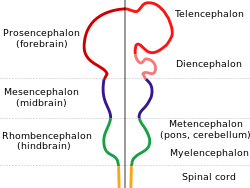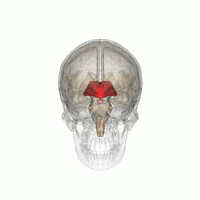Diencephalon
| Diencephalon | |
|---|---|
 Diagram depicting the main subdivisions of the embryonic vertebrate brain. These regions will later differentiate into forebrain, midbrain and hindbrain structures. | |
 Reconstruction of peripheral nerves of a human embryo of 10.2 mm. (Label for Diencephalon is at left.) | |
| Details | |
| Identifiers | |
| Latin | diencephalon |
| MeSH | D004027 |
| NeuroLex ID | birnlex_1503 |
| TA98 | A14.1.03.007 A14.1.08.001 |
| TA2 | 5661 |
| TH | H3.11.03.5.00001 |
| FMA | 62001 |
| Anatomical terms of neuroanatomy | |
The diencephalon ("interbrain") is the region of the vertebrate neural tube which gives rise to posterior forebrain structures. In development, the forebrain develops from the prosencephalon, the most anterior vesicle of the neural tube which later forms both the diencephalon and the telencephalon. In adults, the Diencephalon appears at the upper end of the brain stem, situated between the cerebrum and the brain stem. It is made up of four distinct components: the thalamus, the subthalamus, the hypothalamus and the epithalamus.[1]
Organization
- diencephalon
- mid-diencephalic territory
- hypothalamus
- epithalamus
- pretectum
- pineal gland
- metathalamus
Roles
The diencephalon is the region of the embryonic vertebrate neural tube that gives rise to posterior forebrain structures including the thalamus, hypothalamus, posterior portion of the pituitary gland, and pineal gland. The hypothalamus performs numerous vital functions, most of which relate directly or indirectly to the regulation of visceral activities by way of other brain regions and the autonomic nervous system.

Three-dimensional representation
See also
References
- ^ Jacobson & Marcus (2008). Neuroanatomy for the Neuroscientist. Springer. p. 147. ISBN 978-0-387-70970-3.

